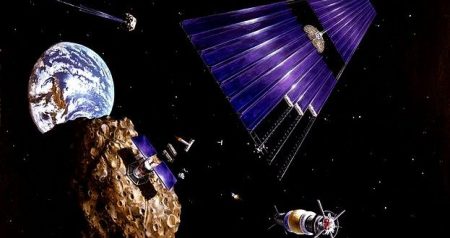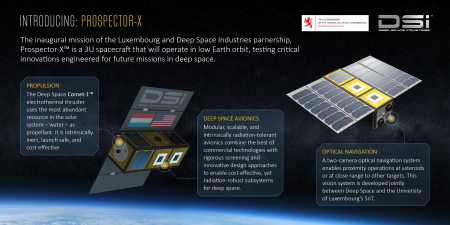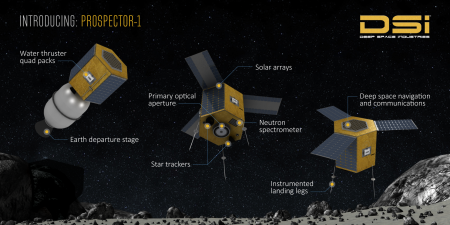August 10, 2016 – We are less than a year away from seeing the first commercial mining operator launch a test mission into near-earth orbit with plans to follow up before the decade is out to begin mining asteroids.
Deep Space Industries‘ (DSI) launch of Prospector-X (see infographic below) will test out all systems to ensure that the sequel, Prospector-1, succeeds as the first space mining mission to an asteroid.
States Grant Bonin, chief engineer, “DSI is developing Prospector-1 both for its own asteroid mining ambitions, as well as to bring an extremely low-cost, yet high-performance exploration capability to the market. We hope to enable both existing and new public and private organizations to explore the inner solar system using this affordable platform.”
DSI is a California company with roots in NASA’s Ames Research Laboratory. Recently it entered into partnership with the nation of Luxembourg who through the Spaceresources.lu initiative have established a European equivalent to the American commercial space act. The goal is to give Europe the ability to create a space-based economy using in situ space resources.
DSI isn’t the only company with which Luxembourg is working. A similar understanding has been entered into with Planetary Resources, a rival to DSI in the race to mine asteroids.
What is novel about DSI’s technology?
Prospector-1 weighs less than 50 kilograms (110 pounds) when fueled so it doesn’t require a powerful booster rocket to get it to orbit and beyond. It also uses a water propulsion system called Comet (TM) that generates thrust by expelling heated water vapour. Comet is an electrothermal micro-propulsion thruster that can be incorporated into a wide range of spacecraft. The advantage of this propulsion technology is that it can harvest water from the asteroids it visits and refuel.
As its name suggests the Prospector-1 is an exploration spacecraft designed to assess a target for its resource value. It has on board an optical navigation system, visible and mid-wave infrared camera, a scanning antenna and star tracker for deep space navigation and communication, and a triple array of solar panels. It is capable of studying an asteroid in detail, able to assess its resource content including locating water ice to a depth of one meter (3.3 feet) below the surface regolith. Once Prospector-1 successfully maps the asteroid it will touchdown on the surface with its instrumented landing legs testing the geological characteristics of the surface.
The follow up mission is a mining robotic spacecraft which will upon rendezvous and contact with the asteroid begin the process of harvesting water ice for fuel and other materials of value for return to Earth orbit. Once back the mining spacecraft will rendezvous with a harvester in orbit which will perform material separation. Materials from these missions will be used to build a space manufacturing capacity capable of fabricating structures impossible to launch and assemble from Earth. These mega-structures will become the home of humans in Deep Space. Other structures will be sent to the Moon or Mars where they will serve to make us an interplanetary species.


















